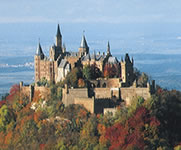Visitors entering the ancient Brömserburg Castle, an impressive sight in itself, are taken on a journey through 1,000 years of fascinating wine history. Old wooden and iron screw wine presses, a historical tree press dating back to 1594, and wine barrels, barrel carts and wine pumps are all displayed in the castle gardens, and approximately 2,000 wine-related exhibits from antiquity to the present day are on show in the halls and vaults inside. Historical tools indicate how much harder the work of wine-growers, cellar masters and barrel coopers used to be compared to today. Particular highlights of the collection include exquisite glasses representing all of the important stylistic periods in Europe. Open from mid-March to the end of October. Guided tours for groups only - available on request.
» www.rheingauer-weinmuseum.de
As a result of its centuries-old winegrowing tradition, Metzingen's Kelterplatz square is home to a group of very special historical buildings. In addition to a wine museum and a wine shop, the seven historical wine presses also offer plenty of conviviality. Built in 1655, the Herrschaftskelter press once owned by Zwiefalten Abbey is the only wine press to retain its historical press beam, making it a monument of technical culture. The Wine Museum opened in this building in 1979 is one of the most interesting in the country. It illustrates local winegrowing techniques and the use of tools for cultivating soil, harvesting and in the wine-making process. The work of coopers and distillers is presented in complete replica workshops. Open on Sundays from the end of April to the end of October. Guided tours for groups available on request.
» www.weinbaumuseum-metzingen.de
Uhlbach is the place for those who know and love fine wines. The Viticulture Museum opened in 1979 in the former village wine press building, dating from 1907. On display is an extensive collection of objects from more than 750 years of local winegrowing tradition. A complete cooper's workshop gives an idea of work in the 18th and 19th centuries. Some exhibits even date back to the time of the Romans, such as drinking vessels and wine receptacles made of tin, clay and stoneware. There are also wooden barrels, certificates, a collection of corkscrews and a depiction of Pope Urban, the 16th-century patron saint for wine-growers. Text and pictures illustrate grape varieties, pest control, the harvest and vineyard consolidation. Open from April to October on Saturdays, Sundays and public holidays.
» www.stuttgart-tourist.de/DEU/freizeit/weinbaumuseumaltekelter.htm
This historical wine-growing estate, founded by the Wettin dynasty in 1401 and steeped in five hundred years of Saxon Elector tradition, is today a centre for culture and viticulture. Surrounded by vineyards, the Winery Museum features exhibitions and a collection which illustrate not only the cultivation of vines and the processing of grapes, but also the consumption of wine and associated festivities, including the changes since the days of the Wettin dynasty. The museum exhibitions are presented inside the main buildings, the Lust- und Berghaus, Pressenhaus and Kavalierhaus, in the vintner's house and outside. The estate also comprises a winery and a tavern. Closed on Mondays.
» www.weinmuseum.de
The Moselle Wine Museum, which opened in an outbuilding of St. Nicholas's Hospital in Bernkastel-Kues in 1979, houses a collection of old equipment and tools used by vintners over the last two centuries. The museum presents the vintner's work over the course of a year and illustrates all aspects of viticulture with exhibits such as glasses, drinking vessels, bottles and other cultural objects from Germany's wine-growing regions spanning several centuries. The collection also includes documents about the history of winegrowing on the Moselle. Open all year round. Guided tours on request.
» www.bernkastel-kues.de
In 1986, the Viticulture Museum was opened in Deidesheim's historical town hall, also known for its grand external staircase. In addition to winegrowing, a wide range of other aspects of wine culture are also on display. There is an extensive collection of drinking vessels from antiquity to the present day. Ancient amphora and glasses from the art nouveau period illustrate how wine glasses and containers have changed over time. The Figurenraum shows models of vintners, wine inspectors and coopers hard at work in life-sized dioramas, while a reconstruction of a 19th-century vintner's home gives an idea how wine growers used to lived. The museum also covers the connections between wine and religion, medicine, poetry, music and history. Closed on Mondays, Tuesdays and in January and February.
» www.weinkultur-deidesheim.de



